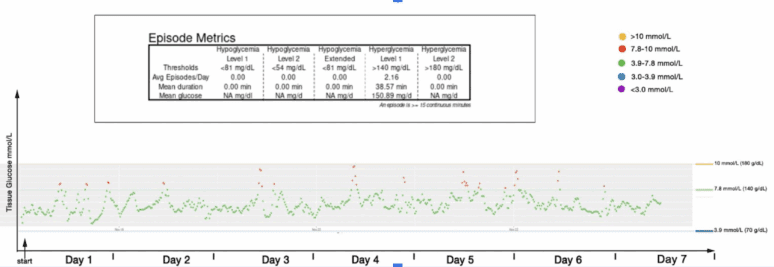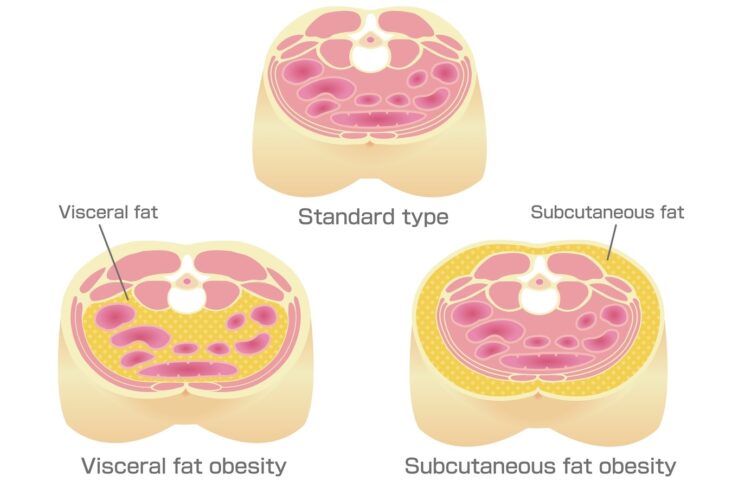
You can read or listen (see podcast construct beneath) to this article authored by Dr Edward Leatham, Consultant Cardiologist
Tags: GLP-1, CGM, Glucose, Podcast search website using Tags to find related stories.
If you have been diagnosed with coronary heart disease or high blood pressure, and carry excess weight — especially around your middle — you are not alone. Due to the interaction between our genes, modern lifestyles and diet, visceral fat deposition has become an almost universal feature of ageing. In addition, many people affected also show signs of glucose dysregulation — often referred to as non-diabetic hyperglycaemia — which is associated with insulin resistance. Together, these factors can significantly affect your healthspan.
The current accepted medical practice is to reserve modern medicines and treat once someone develop diabetes. However it can be argued that the key should be to prevent non diabetic hyperglycaemia state developing into full blown diabetes, which is often associated with multiple complications. Metabolic dysfunction -associated steatotic liver disease MASLD, also known as fatty liver/NAFLD-non alcoholic liver disease, is a condition commonly associated with being overweight. Fatty changes are seen within the liver which could lead to chronic liver disease. In both non diabetic hyperglycaemia and MASLD, the focus should be reversing the glucose dysregulation and reducing visceral fat at the onset rather than waiting for the complications to develop.
These conditions often occur together and are linked by a common underlying issue: metabolic dysfunction. The encouraging news is that we now understand this process can often be slowed — and in many cases, even reversed. Better still, we are learning to do this more effectively through a powerful combination of modern medication, technology, and lifestyle change.
In this blog, I will introduce an approach we refer to as the Metabolic Reset — a structured 8-month programme that uses modern tools such as GLP-1 mimetic injections, continuous glucose monitoring (CGM), a food analysis app, resistance training, and a protein-forward diet. The aim is to reduce visceral fat, build muscle, and reboot your metabolism — with the ultimate goal of minimising the need for long-term medication.
It is worth noting that, prior to joining the programme, many of our patients undergo a metabolic health assessment wearing a CGM and keeping a detailed food diary. This helps us assess the degree of glucose dysregulation and carbohydrate sensitivity present. In milder cases of non-diabetic hyperglycaemia, patients can use our toolkit to address these issues without the need for GLP-1 mimetic therapy — with the option to escalate to a pharmacologically assisted Metabolic Reset, only if needed.
Why Target Visceral Fat and Muscle Mass?
Two key, modifiable drivers of poor metabolic health are:
- Visceral fat: This is the harmful fat stored deep in the abdomen around your organs. It is strongly linked to high blood pressure, fatty liver, insulin resistance, and cardiovascular disease.
- Skeletal muscle mass: Muscle is the engine of your metabolism. It helps burn glucose, regulate insulin, and support a healthy weight.
As we age — particularly if we have inherited genes that predispose us to metabolic disarray that accompanies modern diet and lifestyles, we start to gain weight as visceral fat increases, and muscle mass declines. This double effect worsens blood pressure, cholesterol triglycerides, and blood sugar — contributing to what is known as the metabolic syndrome. Fat cells that have reached their capacity to store surplus diet-derived energy (as a healthy reserve) start to cause metabolic mayhem by releasing free fatty acids (FFAs). These FFAs can impair insulin’s ability to signal glucose uptake in muscle and liver cells, leading to insulin resistance. This process can contribute to a vicious cycle, as insulin resistance can further stimulate FFA release from adipose tissue.
However, if we can reduce visceral fat, rebuild skeletal muscle, and reach a caloric deficit, we can reverse many of these effects.
Introducing the 8-Month Metabolic Reset Programme
This reset is not a fad diet or quick fix. It is a structured intervention designed to change your body from the inside out, addressing the root causes of your metabolic problems. Here is what it involves:
1. GLP-1 Mimetics: Kickstarting Fat Loss and Appetite Reset
GLP-1 mimetics are a class of medications (administered as weekly injections) that mimic a natural hormone called glucagon-like peptide-1. These medications:
- Suppress appetite
- Slow gastric emptying
- Help the pancreas release insulin in response to food
- Reduce glucagon levels (which raise blood sugar)
- Promote weight loss — especially visceral fat
For patients with heart disease and glucose dysregulation, they offer both cardiovascular and metabolic protection.
In this programme, GLP-1 mimetics are used for 8 months, usually with gradual dose escalation. However, unlike many traditional weight-loss medications, the aim is not to continue indefinitely. Instead, we use them to shift your metabolism and support new habits — a metabolic springboard.
2. Continuous Glucose Monitoring (CGM): Personalised Nutritional Feedback
Many people are unaware of how strongly their blood glucose responds to specific foods — until they see it with a CGM. This small, wearable device provides real-time feedback on how your body reacts to meals, snacks, stress, and exercise.

In this non -diabetic patient with a normal HbA1c, there are an average of 2 glucose excursions of blood glucose > 7.8 mmol/L per day related to carbohydrate intake, a pattern seen in many similar patients.
For individuals with prediabetes or glucose dysregulation, CGM can be transformative. It helps you to:
- Identify foods that spike your glucose (often starchy or highly processed carbohydrates)
- Choose low glycaemic alternatives that stabilise blood sugar
- Monitor improvements in glucose control as visceral fat decreases
In this programme, CGM serves as both a learning tool and a motivator, empowering you to take control of your food choices with immediate feedback.
3. Protein-Forward Diet: Fuel Muscle and Satiety
As visceral fat is reduced, it is vital to protect and build muscle mass — particularly for individuals over the age of 50. This requires two key elements:
- Adequate protein intake — to provide the amino acids needed for muscle repair and maintenance
- Resistance training — to signal the body to preserve or increase muscle mass
Most people do not consume sufficient protein for metabolic health. In this programme, we aim for:
- 1.2–1.6 grams of protein per kilogram of body weight per day
- Protein at each meal, not just in the evening
- Meals paired with fibre-rich vegetables and healthy fats
Importantly, protein also stimulates your own natural GLP-1 production. That means that over time, your body begins to regulate appetite more effectively — helping you transition off medication.
4. Resistance Training: Rebuild the Metabolic Engine
Muscle does more than move the body — it acts as a metabolic powerhouse. More muscle means better insulin sensitivity, improved glucose control, and greater calorie expenditure at rest.
Even basic resistance training (2–3 times per week) can:
- Lower blood glucose
- Improve insulin resistance
- Increase resting metabolic rate
- Prevent age-related muscle loss (sarcopenia)
You do not need to join a gym. Simple home-based exercises using body weight, resistance bands, or light dumbbells are a great place to begin. The priority is consistency and progression.
What to Expect Over 8 Months
Month 1–2: Initiation Phase
- Agree on target achievable weight at the beginning
- Start GLP-1 mimetic at low dose, increase as tolerated
- Consider using CGM to assess glycaemic response to foods (especially if you were glucose dysregulated before)
- Introduce basic resistance training
- Transition diet: increase protein, reduce refined carbohydrates
Expected outcomes: Appetite reduction, 2–5% weight loss, early visceral fat reduction, improved post-meal glucose responses
Month 3–5: Acceleration Phase
- Reach therapeutic GLP-1 dose
- Use CGM data to guide food choices
- Resistance training becomes part of routine
- Waist circumference begins to drop
- Likely improvement in glycaemic and MASLD blood markers
Expected outcomes: 5–10% total body weight loss, increased insulin sensitivity, improved energy levels, lowered blood pressure
Month 6–8: Transition Phase
- Emphasis shifts to muscle preservation and metabolic independence
- Protein intake and strength training remain central
- For those reaching weight goals, begin tapering GLP-1 dose under supervision
Expected outcomes: Stable lean mass, reduced visceral fat, better metabolic flexibility, readiness to stop medication
How Do We Measure Success?
This programme looks beyond the bathroom scales. We offer track:
- Waist circumference — a practical marker of visceral fat loss
- Food group quantification – using Dr Shape, an AI-guidied food analysis app
- Blood pressure and HbA1c — for cardiovascular and metabolic risk reduction
- Functional improvements — such as walking stamina or strength
There are also options to also track:
Body composition — using smart scales or DEXA scans to track fat and muscle balance
CGM trends — with fewer glucose spikes after meals
Is This Just Another Weight-Loss Programme?
No — this is not a “slimming club” or crash diet.
The Metabolic Reset is a clinically designed, time-limited intervention aimed at reversing the biological causes of weight gain, glucose problems, and high blood pressure. By reshaping body composition and restoring metabolic balance, we are not just treating symptoms — we are tackling the root cause.
Can I Stop the Injections After 8 Months?
In many cases, yes — that is the goal.
If, by 8 months, you have:
- Reduced visceral fat
- Increased or preserved muscle
- Achieved stable post-meal glucose levels on CGM
- Built sustainable nutrition and activity habits
…then you may be able to taper off GLP-1 mimetics without rebound weight gain or worsening metabolic markers. This is always done under medical guidance.
Remember: the medication is the bridge — not the destination.
Final Thoughts:
Every week I meet patients who feel stuck — in a cycle of weight gain, fatigue, medication, and worsening blood pressure or blood sugar. But your body is capable of change. With the right tools, knowledge, and support, you can rebuild a healthier metabolism.
If you have cardiovascular disease, carry excess weight, or have signs of insulin resistance, you do not need to wait until diabetes develops. This structured reset can change your trajectory.
It is not easy — but it is achievable. And it is worth it.
Interested in a Reset?
Speak to your doctor or see our GLP-1 mimetic clinic to discuss:
- Whether GLP-1 mimetics are appropriate for you
- Using a CGM to understand your unique glucose responses
- Support for nutrition and resistance training tailored to your needs
We are no longer just managing numbers. We are restoring metabolic health from the inside out.
Related posts and articles
- Visceral adipose tissue and residual cardiovascular risk: a pathological link and new therapeutic options 2023
- How to Lose Visceral Adipose Tissue (VAT) and Improve Metabolic Health: A Guide to Sustainable Weight Loss
- Dietary Fats: From Villain to Vital Nutrient – Rethinking Fat in a Heart-Healthy Diet
- Protein, Sarcopenia, and the Pursuit of Healthspan
The Naked Heart is an educational project owned and operated by Dr Edward Leatham. It comprises a series of blog articles, videos and reels distributed on Tiktok, Youtube and Instagram aimed to help educate both patients and healthcare professionals about cardiology related issues.
If you would like to receive email notification each week from the Naked Heart, follow me on social media or please feel free to subscribe to the Naked Heart email notifications here






